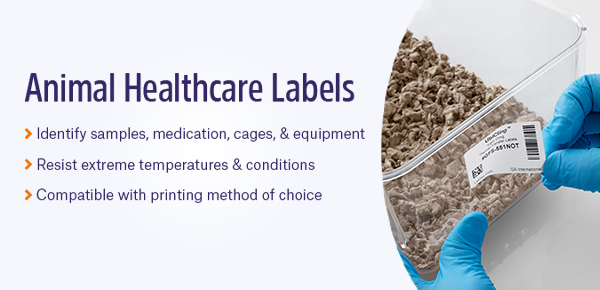![]()
Barcodes and radio-frequency identification (RFID) are staples of research facilities, hospitals, and other healthcare institutions, used to identify everything from samples to reagents, patients, and instruments. Their place isn’t limited to indoors, though; scientists are now using these two highly efficient methods to track animals in the wild, including ecological monitoring, learning animal behaviors, and ensuring our food is safe to eat.
Animal tagging
Automated RFID and barcode systems have been in use for several years already. RFID tags are especially popular for livestock management, with farmers using RFID to identify and track livestock inventory, as well as to monitor essential health data of individual animals. Furthermore, RFID is also used to track wild animals, including for tracking birds, whose migration patterns are essential to understanding our perpetually evolving ecosystems. RFID systems used for tracking bird migration patterns need not be extremely complex either; Arduino circuit boards, largely considered hobbyist equipment, have been successfully tested in the wild for monitoring breeding behavior as well as for nest box analysis for ducks. Though potentially cheaper, barcode systems appear slightly more complex, as animals carrying “backpacks” containing barcodes printed on paper require proper camera setup and digital extraction of images to properly monitor activity.1,2 Even animals as small as ants are able to monitored using these technologies, with one 2018 study describing the attachment of small QR codes to the back of ants to assess their social behaviors in response to disease.3
Monitoring animals at night presents another challenge entirely. Most types of tags are nearly impossible to see in the dark, making it challenging to track nocturnal animals. One post-doctoral fellow, Yasmine Majchrzak, decided to develop a new method of tracking animals by utilizing heat shrink material. She produced collars and antennae with barcodes made of the material, ultimately making them more reflective and easier to see in the dark. Using this system, she was able to track snowshoe hares, an animal that’s notoriously elusive, especially at night.4
Built-in barcodes
Non-invasive monitoring is an important concept for scientists; actively interfering with an animal can change its disposition, sometimes permanently, making it difficult to assess natural behavior patterns. Collaborators from the University of Illinois-Chicago and Princeton University decided to invent a new way of tracking animals, specifically zebras: a zebra stripe barcode detector. The invention, called StripeSpotter, takes images of zebras and discerns their stripe pattern. In doing so, it uses an algorithm to compare the patterns, which helps identify unique individuals from each other. With only a camera and a laptop running the app, databases are generated to help scientists assess whether the animal has been spotted prior and to track them over the long term. Currently, the program has only been officially implemented in Kenya to spot zebras. However, its developers acknowledge that the program could also theoretically be used for other striped animals, like tigers.5
DNA barcodes
Originally developed by a Canadian scientist, Dr. Paul Hebert, in the early 2000s, DNA barcoding is a technique wherein specific regions of a given species’ chromosomal DNA are used for creating a database to identify many individual species. The DNA regions chosen to represent each species should have low intra-specific variability but high inter-specific variability; that is, the sequence appears nearly 100% of the time in its intended species but never in other species. Different genes are often used to identify different groups of animals. For instance, the sequence of mitochondrial cytochrome C oxidase I is usually used to identify animals. In animals, mitochondrial genes represent a better option than nuclear genes as they lack introns, utilize a haploid mode of inheritance, and recombination rarely occurs.6
Over the years, DNA barcoding has been co-opted for a variety of uses, including:7
- Novel species discovery: With the help of an extensive database of species, DNA barcoding can help identify whether a species has been discovered previously. Projects like the International Barcode of Life (iBOL) program have been working to make the technique more widely accessible so that scientists can continue to detect new species.
- Invasive species detection: Environmental DNA (eDNA) obtained from a myriad of types of samples, like soil and water, can be analyzed via PCR to monitor the presence of invasive species, many of which represent potential ecological dangers.
- Ecological conservation: Using eDNA, scientists can also understand changing trends in biodiversity and how they are affected by climate change and other environmental hazards.
- Food safety analysis: Not all food is what it seems. Using DNA barcoding, several cases have been discovered where specific types of meat and fish were not labeled correctly. As such, this technique represents a way to identify fraud in the food supply chain, as well as poachers killing animals and selling their meat illegally.
LabTAG by GA International is a leading manufacturer of high-performance specialty labels and a supplier of identification solutions used in research and medical labs as well as healthcare institutions.
References:
- Alarcón-Nieto G, et al. An automated barcode tracking system for behavioural studies in birds. Methods Ecol Evol. 2018;9:1536–1547.
- Bridge ES, et al. An Arduino-Based RFID Platform for Animal Research. Front Ecol Evol. 2019;7.
- Stroeymeyt N, et al. Social network plasticity decreases disease transmission in a eusocial insect. Science. 2018;362(6417):941-945.
- Majchrzak Y, et al. A method for marking individual animals in motion-triggered camera studies. Mamm Biol.
- StripeSpotter turns wild zebras into trackable barcodes.
- Hebert PDN, et al. Barcoding animal life: cytochrome c oxidase subunit 1 divergences among closely related species. Proc Royal Soc Biol Sci. 2003;270(Suppl 1):S96-S9
- Bento Lab. DNA barcoding workflows: Using DNA barcodes to identify fungi, plants and animal.



